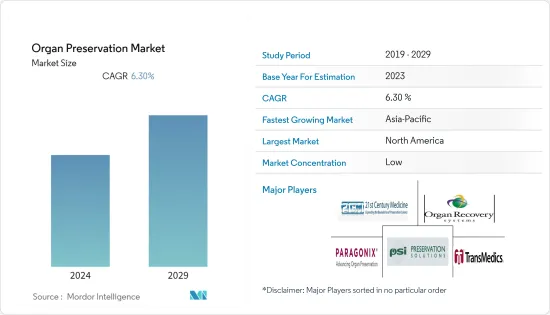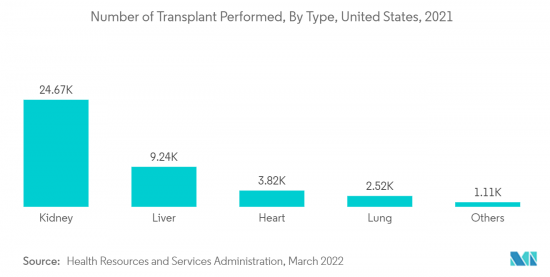PUBLISHER: Mordor Intelligence | PRODUCT CODE: 1405694

PUBLISHER: Mordor Intelligence | PRODUCT CODE: 1405694
Organ Preservation - Market Share Analysis, Industry Trends & Statistics, Growth Forecasts 2024 - 2029

The organ preservation market is expected to register a CAGR of 6.3% over the forecast period.
The coronavirus infection has impacted all aspects of healthcare, including the execution of life-saving treatments such as organ transplantation, by affecting the process of organ donation and recovery. The emergence of COVID-19 has had a significant influence on organ donation and transplantation around the world. It has interrupted these actions and drastically curtailed donation and transplant activities worldwide, resulting in a drop in demand for organ preservation products. According to the study published in the Israel Journal of Health Policy Research in January 2022, compared to pre-pandemic figures, the number of organs retrieved per donor decreased during the pandemic (from 3.8/donor to 3.4/donor ). Thus decreasing organ preservation during the pandemic. However, the market is gradually stabilizing as COVID-19 cases are declining, resulting in the return of the normal demand levels for organ preservation. Thus, COVID-19 is expected to significantly impact the organ preservation market over the forecast period.
Factors driving the market growth include rising cases of multiple organ failure in the aging population, technological advancements, and increasing government and NGO initiatives to encourage organ donation. When people have chronic kidney disease (CKD), their kidneys get damaged and may not clean the blood as healthy kidneys do over time. For instance, in April 2021, as per an article published by Aging and Disease Editorial, renal mass declines by about 10% per decade from 30 to 80 years old as people age. Renal blood flow decreases by approximately 10% per decade, along with a decline in glomerular filtration rate at a similar rate after age 40. However, single-nephron glomerular filtration rate and glomerular volume remain relatively constant with healthy aging. Thus, the surge in organ diseases may contribute to organ failure, leading to the need for organ transplantation, thus increasing the demand for organ preservation.
Additionally, various initiatives are taken by the government to promote organ donation, further expanding the market growth. For instance, in April 2021, the Biostasis Research Institute launched and funded the Organ and Tissue Preservation Center at the University of Minnesota to focus on technologies to safely and rapidly rewarm cryopreserved organs and other living systems. Similarly, in September 2021, Shenna Bellows, Secretary of State, joined organ donor recipients and supporters in launching a state-wide Maine Organ Donation Campaign. Banners and window clings are being placed in BMV offices to educate the public and encourage donors to register.
Thus, all the above-mentioned factors are expected to boost market growth over the forecast period. However, the high cost of organ transplantation may restrain the market growth over the forecast period.
Organ Preservation Market Trends
Liver Segment holds Significant Share of the Organ Preservation Market
Liver preservation, also called hepatic preservation, can help save one's life when the liver no longer works. A doctor may advise a liver transplant from a preserved liver for a person with end-stage liver disease. The segment is driven by the growing prevalence of liver diseases, increased liver transplants, and various products launched by the key market players. For instance, according to Johns Hopkins Medicine, in June 2022, of the 138 liver transplants performed at Johns Hopkins in 2021, about 14% involved a living donor. Furthermore, according to an article published by Medscape, in April 2022, 9236 patients received a liver transplant and 12,800 patients were added to the waiting list for a liver transplant in the previous year. Thus, the surge in the number of patients requiring liver transplants is expected to increase the demand for liver preservation, therefore driving the growth of the market.
Technological advancement and increased product launches are expected to propel the market's growth. For instance, in November 2021, Paragonix Technologies, a donor organ preservation and transport system manufacturer, introduced the LIVERguard Donor Liver Preservation System in the United States and Europe. Similarly, in September 2021, TransMedics Group, Inc., received the U.S. Food and Drug Administration (FDA) premarket approval (PMA) for the OCS Liver System for use with organs from donors who died after brain death (DBD) and after circulatory death (DCD).
Thus, owing to rising company activiites, the growing prevalence of liver diseases and increased liver transplants are expected to boost segment growth over the forecast period.

North America Hold Significant share in the Global Organ Preservation Market
The rising demand for organ transplantation and product launches by the key market players is propelling market growth across the entire region. As per the data published by the Health Resources and Services Administration in March 2022, about 40,000 organ transplants were performed in the United States in 2021. In addition, 26,670 kidney transplants and 9,236 live transplants were performed in 2021 the United States. Moreover, according to updates in June 2022, 2,782 organ transplants were done in Canada in the previous year. In 78% of transplants, deceased donor organs were used, while 21% used living donor organs. Institutes of Health Information Canadian, The rising demand for organ transplantation is expected to increase the demand for reliable organ preservation systems.
Several initiatives launched by the NGOs in the United States encourage organ donation, which may further contribute to market growth over the forecast period. For instance, in October 2021, Donate Life Kentucky launched a new awareness campaign, "Be The One," to raise awareness about organ donation and transplantation among Black communities around the state.
Moreover, in May 2022, X-Therma Inc. announced that the Center for Devices and Radiological Health (CDRH) of the Food and Drug Administration (FDA) has granted its proprietary organ preservation solution, XT-ViVo, and TimeSeal Organ Transport Device, Breakthrough Device status.
All these factors create a favorable scenario for organ donation and organ transplants across the region, eventually fuelling market growth.
Organ Preservation Industry Overview
The oncology nutrition market is moderate due to the presence of companies operating globally and regionally. The competitive landscape includes an analysis of a few international as well as local companies which hold market shares and are well-known, including 21st Century Medicine Inc., Essential Pharmaceuticals LLC, Organ Recovery Systems, Inc., Organox Limited, Paragonix Technologies, Inc., Preservation Solutions, Inc., Transmedics, Inc., Waters Medical Systems LLC, and Xvivo Perfusion AB, among others.
Additional Benefits:
- The market estimate (ME) sheet in Excel format
- 3 months of analyst support
TABLE OF CONTENTS
1 INTRODUCTION
- 1.1 Study Assumptions and Market Definition
- 1.2 Scope of the Study
2 RESEARCH METHODOLOGY
3 EXECUTIVE SUMMARY
4 MARKET DYNAMICS
- 4.1 Market Overview
- 4.2 Market Drivers
- 4.2.1 Rising Cases of Multiple Organ Failure in Ageing Population
- 4.2.2 Technological Advancements
- 4.2.3 Increasing Government and Non-profit Organisation Initiatives to Encourage Organ Donation
- 4.3 Market Restraints
- 4.3.1 High Cost of Organ Transplantation
- 4.3.2 Limited Medical Reimbursements for Organ Donation and Transplantation
- 4.4 Porter's Five Forces Analysis
- 4.4.1 Bargaining Power of Suppliers
- 4.4.2 Bargaining Power of Buyers/Consumers
- 4.4.3 Threat of New Entrants
- 4.4.4 Threat of Substitute Products
- 4.4.5 Intensity of Competitive Rivalry
5 MARKET SEGMENTATION (Market Size by Value - USD)
- 5.1 By Technique
- 5.1.1 Static Cold Storage (SCS) Technique
- 5.1.2 Hypothermic Machine Perfusion
- 5.1.3 Normothermic Machine Perfusion
- 5.2 By Product Type
- 5.2.1 Preservation Solutions
- 5.2.2 Transport Systems
- 5.2.3 Others
- 5.3 By Organ Type
- 5.3.1 Kidneys
- 5.3.2 Liver
- 5.3.3 Lung
- 5.3.4 Heart
- 5.3.5 Others
- 5.4 Geography
- 5.4.1 North America
- 5.4.1.1 United States
- 5.4.1.2 Canada
- 5.4.1.3 Mexico
- 5.4.2 Europe
- 5.4.2.1 Germany
- 5.4.2.2 United Kingdom
- 5.4.2.3 France
- 5.4.2.4 Italy
- 5.4.2.5 Spain
- 5.4.2.6 Rest of Europe
- 5.4.3 Asia-Pacific
- 5.4.3.1 China
- 5.4.3.2 Japan
- 5.4.3.3 India
- 5.4.3.4 Australia
- 5.4.3.5 South korea
- 5.4.3.6 Rest of Asia-Pacific
- 5.4.4 Middle East and Africa
- 5.4.4.1 GCC
- 5.4.4.2 South Africa
- 5.4.4.3 Rest of Middle East and Africa
- 5.4.5 South America
- 5.4.5.1 Brazil
- 5.4.5.2 Argentina
- 5.4.5.3 Rest of South America
- 5.4.1 North America
6 COMPETITIVE LANDSCAPE
- 6.1 Company Profiles
- 6.1.1 21st Century Medicine Inc.
- 6.1.2 Accord Healthcare Inc. (Intas Pharmaceuticals)
- 6.1.3 Organ Recovery Systems, Inc.
- 6.1.4 Organox Limited
- 6.1.5 Paragonix Technologies, Inc.
- 6.1.6 Preservation Solutions, Inc.
- 6.1.7 Transmedics, Inc.
- 6.1.8 Waters Medical Systems LLC
- 6.1.9 Xvivo Perfusion AB
7 MARKET OPPORTUNITIES AND FUTURE TRENDS




